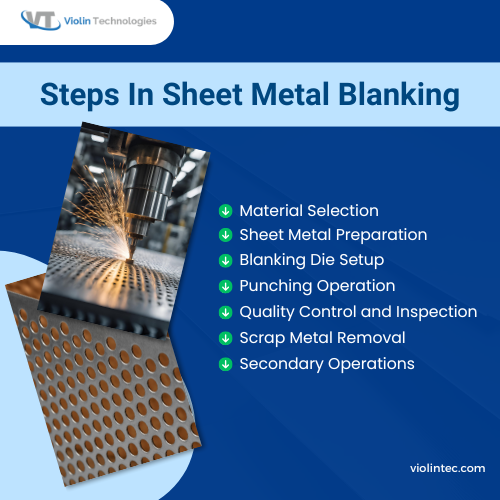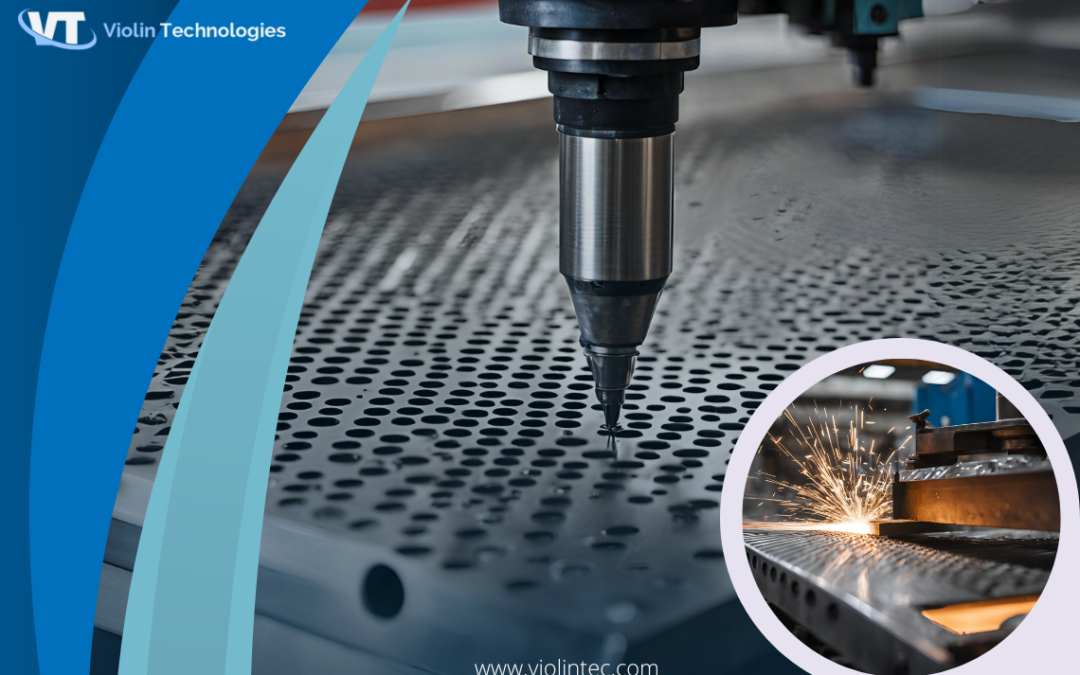What we cover in this blog?
Key Takeaways
- Sheet metal blanking ensures precision cutting with accurate part dimensions.
- High-speed production increases manufacturing efficiency.
- Blanking minimizes material waste, lowering costs..
- Ideal for producing complex shapes in large volumes.
Steps In Sheet Metal Blanking Operation
Material Selection
The blanking process begins with selecting the appropriate material for the project. The right material depends on the project’s specific requirements, including the final product’s intended function in the metalworking industry and the environmental conditions it will face.
For instance, alloy steel is frequently selected for its corrosion resistance, while carbon steel is favored for its durability. Additionally, the metal’s material thickness is crucial and must align with the final product’s specifications.
Sheet Metal Preparation
Once the material is selected, the next step involves preparing the sheet metal for blanking and forming process. This process typically uses flat metal sheets of different thicknesses, ranging from thin to thicker materials, depending on the project requirements. The metal is cleaned, and surface imperfections are eliminated to ensure smooth cutting. Because any surface defects can result in poor-quality parts or reduce the accuracy of the shearing processes.
Blanking Die Setup
Specialized tool steel, known as a blanking die, is used to cut metal out. This die is custom-made to punch out the desired shape from the metal sheet and is installed in a metal stamping process. The die consists of two main parts: the punch and the die cavity. The metal sheet is positioned between these components, and the punch exerts force to push the material into the die cavity, cutting it into the intended shape.
Contract Manufacturers in India offer reliable and cost-effective solutions for producing high-quality products across various industries.
Punching operation
During the stamping process and cutting phase, the metal sheet is placed in a press, where a punch forces it through a die. This action shears the metal deformation along the die’s edges to produce the desired part. The blanking process typically yields clean, smooth edges, although there may be instances of rough edges or burrs that need further attention.
Since blanking is considered a cold working method, no heat is applied to the metal. Instead, the punch applies significant pressure, causing the material to deform until it fractures and takes on the target form.
Quality Control and Inspection
After the sheet metal blanking operation is completed, the produced components are thoroughly inspected to ensure they meet quality assurance standards. The quality control team ensures that every single piece is absolutely perfect, especially when making parts for cars or planes.
They check along the edges for rough spots and scan the surface like they’re searching for errors or the tiniest imperfections. In situations where extreme accuracy is essential, fine blanking techniques can be applied to create cleaner edges and tighter tolerances, which helps to reduce the need for additional finishing processes.
Scrap Metal Removal
A byproduct of the metal cutting process is metal waste, which consists of the leftover material after the desired shape has been cut from the sheet. This scrap material is collected and can either be recycled or reused, contributing to reducing material, minimizing waste, and improving the overall efficiency of the manufacturing process. Many blanking setups are specifically designed to minimize scrap generation by optimizing the layout of the blanks on the metal sheet, ensuring that as much material as possible is utilized.
Partner with trusted Sheet Metal and Stamped parts suppliers to achieve precision-engineered components for a variety of industries.
Secondary Operations
After blanking, some projects may require additional steps known as secondary operations. These may include deburring—smoothing out sharp edges—as well as surface finishing techniques like polishing or applying protective coatings. Forming processes might also be employed to bend or reshape the used blanking force. These additional processes not only enhance the product’s visual appeal but also boost its functionality and performance, ensuring it is ready for its intended use.

Benefits of Blanking in Sheet Metal
1. High production rates
Blanking is an excellent example of high production rates for components of sheet metal. Modern blanking machines can produce thousands of parts quickly, making them perfect for situations where speed and efficiency are critical.
2. Minimize Manpower Interventions
Modern blanking machines have automated functionalities with minimal human interference. Once set, they can work continuously without a regular check, which is very efficient.
3. Streamlined Process
The entire process has smoothened the workflow to remain un-disrupted and smooth. Everything from the calibration of a machine to the expulsion of a blank to its re-calibration for further usage goes into that smoothed and streamlined process. This process increases productivity and also cuts down considerably on downtime.
4. Consistent quality
Each blanked item is almost a perfect replica of its parent. The process of blanking is so precise that every product manufactured fits the set quality parameters without any scope for labor work deviations.
5. Tight tolerances
In industries, minute differences sometimes lead to inefficient working and pose a dangerous situation. High-tech blanking dies, and tooling possess the tightest tolerances. In other words, all the blanked pieces meet the required tolerance levels.
6. Reduces Material Waste
Producing component blanks with advanced blanking tools and techniques, proper nesting, and placement of parts onto the metal sheet minimize material wastage and, hence, material costs.
7. Lower Labor Cost
Automation and efficiency in the blanking mean fewer people are required. When machinery does most of the work, labor costs go down significantly.
8. Eliminates Secondary Processes
Because the blanked parts are so precise and quality-oriented, most of the time, it is only sometimes necessary to carry out other secondary processes, such as edge finishing. It not only saves you your time but also saves money directly.
Custom Sheet Metal Manufacturers create high-quality, tailored sheet metal projects and components for your specific project needs.
Conclusion
Sheet metal blanking is a vital metalworking process that shapes thin metal sheets into precise tolerances for numerous applications. From material selection to finishing operations, each phase of the blanking process plays an important role in producing quality parts while minimizing waste. As a crucial element of sheet metal fabrication, blanking is especially significant in the manufacturing sector, particularly for mass production.
Frequently Asked Questions
What is the difference between blanking and punching?
Blanking and punching are similar but serve different purposes. Blanking aims to cut out the desired part (the blank), leaving the remaining material as scrap. In contrast, the punching process focuses on removing material, with the leftover sheet being the desired part.
What materials are suitable for the blanking process?
Commonly used materials include stainless steel, carbon steel, aluminum, copper, and other metals, each providing unique properties like resistance to oxidation and the ability to conduct electricity.
How does blanking help in reducing material waste?
Blanking minimizes waste through careful planning of blank arrangements on the metal sheet. Any leftover metal thickness scrap can be recycled or reused, helping to lower overall material costs.
What advantages does fine blanking offer over traditional blanking?
Fine blanking provides tighter tolerances and cleaner edges than traditional techniques, making it suitable for applications that require high precision and smooth surfaces. It also reduces the need for additional finishing processes.

Rasmita Patro
About the Author
Meet Rasmita Patro, a content writer, a former teacher, and a former HR with a passion for storytelling, creating compelling content that engages and informs readers. She has a Master’s in Economics and an MBA degree in Human Resources. Her expertise spans a variety of industries, including finance, healthcare, technology, and others. She has a particular inclination toward crafting blog posts, articles, and social media content that resonates with the target audience. She loves reading different genres of books, love to experiment with cooking, and listening to soothing music.

